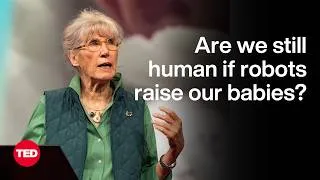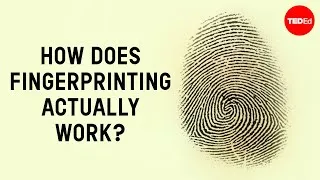请双击下面的英文字幕来播放视频。
翻译人员: Qing Zhang
校对人员: Yongming Luo
00:25
So, where are the robots?
0
25000
2000
啊,机器人们都在哪儿呢?
00:27
We've been told for 40 years already that they're coming soon.
1
27000
3000
四十年前人们就说它们很快就要来了
00:30
Very soon they'll be doing everything for us.
2
30000
3000
很快,它们就能为我们做一切事情
00:33
They'll be cooking, cleaning, buying things, shopping, building. But they aren't here.
3
33000
5000
它们会做饭,打扫,买东西,购物,甚至是建房子。但直到今天,它们也没能进入我们的生活。
00:38
Meanwhile, we have illegal immigrants doing all the work,
4
38000
4000
这段时间里,非法移民承担着这些工作,
00:42
but we don't have any robots.
5
42000
2000
但我们什么机器人都没有。
00:44
So what can we do about that? What can we say?
6
44000
4000
我们又能做些或说些什么呢?
00:48
So I want to give a little bit of a different perspective
7
48000
4000
我想给大家带来点不同的启发
00:52
of how we can perhaps look at these things in a little bit of a different way.
8
52000
6000
看看今天我们能不能换一个角度看待这些事情
00:58
And this is an x-ray picture
9
58000
2000
这是一张X光片
01:00
of a real beetle, and a Swiss watch, back from '88. You look at that --
10
60000
5000
上面有一只活甲虫,和一只88年的瑞士手表,你看——
01:05
what was true then is certainly true today.
11
65000
2000
无论是当时还是现在
01:07
We can still make the pieces. We can make the right pieces.
12
67000
3000
我们都可以做出这些零件,一模一样的零件,
01:10
We can make the circuitry of the right computational power,
13
70000
3000
我们能做出有同样计算能力的电路,
01:13
but we can't actually put them together to make something
14
73000
3000
但我们并不能把它们放在一起,再做出个什么东西
01:16
that will actually work and be as adaptive as these systems.
15
76000
5000
能和这些系统(甲虫)有一样的适应力。
01:21
So let's try to look at it from a different perspective.
16
81000
2000
那么就让我们试着换个角度再看看这个问题。
01:23
Let's summon the best designer, the mother of all designers.
17
83000
4000
让我们召集最好的设计师,所有设计师的鼻祖,
01:27
Let's see what evolution can do for us.
18
87000
3000
看看进化论能给我们做些什么。
01:30
So we threw in -- we created a primordial soup
19
90000
4000
所以我们就找来了--我们创造了一锅“原汤”,
01:34
with lots of pieces of robots -- with bars, with motors, with neurons.
20
94000
4000
里面有组装机器人需要的各种零件:条状的,带马达的,还有些带神经元的。
01:38
Put them all together, and put all this under kind of natural selection,
21
98000
4000
把它们都放在一起,然后把所有这些放到一种自然选择,
01:42
under mutation, and rewarded things for how well they can move forward.
22
102000
4000
可能产生突变的环境中,并奖励那些发生“进化”的零件组。
01:46
A very simple task, and it's interesting to see what kind of things came out of that.
23
106000
6000
这是一个非常简单的任务,并且得出的结果非常有趣。
01:52
So if you look, you can see a lot of different machines
24
112000
3000
看一下,你能看到各式各样的机器
01:55
come out of this. They all move around.
25
115000
2000
在这种模式下制造出来,它们到处移动,
01:57
They all crawl in different ways, and you can see on the right,
26
117000
4000
以不同的方式爬行,在右边你可以看到
02:01
that we actually made a couple of these things,
27
121000
2000
我们真的做出了几个这样的玩意儿,
02:03
and they work in reality. These are not very fantastic robots,
28
123000
3000
它们在现实中真的能工作。这些还算不上非常先进的机器人,
02:06
but they evolved to do exactly what we reward them for:
29
126000
4000
但它们的确按照我们奖励的方向进化了:
02:10
for moving forward. So that was all done in simulation,
30
130000
3000
那就是向前进化。这些都是模拟的,
02:13
but we can also do that on a real machine.
31
133000
2000
但我们在真的机器上也做成功了,
02:15
Here's a physical robot that we actually
32
135000
5000
这是一个真实的机器人,
02:20
have a population of brains,
33
140000
3000
我们动用了大量的人力脑力
02:23
competing, or evolving on the machine.
34
143000
2000
让机器们相互竞争,共同进化
02:25
It's like a rodeo show. They all get a ride on the machine,
35
145000
3000
这有点像一场套马表演:他们都骑在机器上
02:28
and they get rewarded for how fast or how far
36
148000
3000
根据他们能够驾驶机器前进的速度和距离
02:31
they can make the machine move forward.
37
151000
2000
得到奖励
02:33
And you can see these robots are not ready
38
153000
2000
你可以看到这些机器人都还没完全准备好
02:35
to take over the world yet, but
39
155000
3000
占领这个世界,但是
02:38
they gradually learn how to move forward,
40
158000
2000
它们渐渐地学会如何前进
02:40
and they do this autonomously.
41
160000
3000
并且是自发地学习。
02:43
So in these two examples, we had basically
42
163000
4000
所以从这两个例子中,我们已经基本上
02:47
machines that learned how to walk in simulation,
43
167000
3000
得到了能在虚拟中学习走路
02:50
and also machines that learned how to walk in reality.
44
170000
2000
和在现实中学习走路的机器人。
02:52
But I want to show you a different approach,
45
172000
2000
现在我还要再给你们展示另一项进展,
02:54
and this is this robot over here, which has four legs.
46
174000
6000
就是这里的这个机器人,在这儿,它有四条腿
03:00
It has eight motors, four on the knees and four on the hip.
47
180000
2000
它身上安了八个马达,膝盖上四个,腿上四个
03:02
It has also two tilt sensors that tell the machine
48
182000
3000
它还配备了两个倾斜度传感器,可以告诉自己
03:05
which way it's tilting.
49
185000
3000
正在向哪个方向倾斜。
03:08
But this machine doesn't know what it looks like.
50
188000
2000
但这个机器并不知道自己长啥样
03:10
You look at it and you see it has four legs,
51
190000
2000
你可以看到它长了四条腿,
03:12
the machine doesn't know if it's a snake, if it's a tree,
52
192000
2000
但它自己并不知道自己是一条蛇还是一棵树
03:14
it doesn't have any idea what it looks like,
53
194000
3000
它完全给蒙在鼓里,不晓得自己的相貌
03:17
but it's going to try to find that out.
54
197000
2000
但它马上就要试着找到自己
03:19
Initially, it does some random motion,
55
199000
2000
首先,它会做一些随机的动作
03:21
and then it tries to figure out what it might look like.
56
201000
3000
然后试着弄清楚那些动作都看起来是什么样子的——
03:24
And you're seeing a lot of things passing through its minds,
57
204000
2000
你可以看到它的脑海里闪过许许多多的东西,
03:26
a lot of self-models that try to explain the relationship
58
206000
4000
大量的自我尝试的动作模型,试着理清
03:30
between actuation and sensing. It then tries to do
59
210000
3000
行动和感官之间的关系——然后它将再做第二个动作
03:33
a second action that creates the most disagreement
60
213000
4000
在所有可能的动作模型中
03:37
among predictions of these alternative models,
61
217000
2000
最诡异的一个动作,
03:39
like a scientist in a lab. Then it does that
62
219000
2000
就像科学家在实验室里的试验。接着,它重复那个动作,
03:41
and tries to explain that, and prune out its self-models.
63
221000
4000
并且试着解释那个动作,然后梳理出自己的动作模型。
03:45
This is the last cycle, and you can see it's pretty much
64
225000
3000
这是最后一个环节,你可以看到它已经基本上
03:48
figured out what its self looks like. And once it has a self-model,
65
228000
4000
清楚自己的样子了。一旦它理清自己的动作模型,
03:52
it can use that to derive a pattern of locomotion.
66
232000
4000
就可以从模型中得出一种运动模式。
03:56
So what you're seeing here are a couple of machines --
67
236000
2000
好了,你现在看到的是几个机器——
03:58
a pattern of locomotion.
68
238000
2000
嗯,一种运动模式,
04:00
We were hoping that it wass going to have a kind of evil, spidery walk,
69
240000
4000
我们期待它能产生一种邪恶的,蜘蛛式的运动,
04:04
but instead it created this pretty lame way of moving forward.
70
244000
4000
结果它却自创出这种相当脑残的前进方式。
04:08
But when you look at that, you have to remember
71
248000
3000
但当你看着它前进的时候,你必须记得
04:11
that this machine did not do any physical trials on how to move forward,
72
251000
6000
这个机器并没有接受任何物理指令,控制着它们向前进,
04:17
nor did it have a model of itself.
73
257000
2000
它也没有任何已有的自我模型。
04:19
It kind of figured out what it looks like, and how to move forward,
74
259000
3000
它相当于是自己推理出了自己的样子,以及应该如何向前进
04:22
and then actually tried that out.
75
262000
4000
并且进行了亲身的尝试。
04:26
(Applause)
76
266000
5000
鼓掌~~~♫
04:31
So, we'll move forward to a different idea.
77
271000
4000
那么现在,我们再来看看另一个想法。
04:35
So that was what happened when we had a couple of --
78
275000
5000
那是我们将几个...
04:40
that's what happened when you had a couple of -- OK, OK, OK --
79
280000
4000
把几个...放在一块儿就会...好啦好啦好啦——
04:44
(Laughter)
80
284000
2000
(笑)
04:46
-- they don't like each other. So
81
286000
2000
——它们不大喜欢对方,所以啦~
04:48
there's a different robot.
82
288000
3000
这是另外一个机器人。
04:51
That's what happened when the robots actually
83
291000
2000
刚才的那些都是在机器人做对了动作,
04:53
are rewarded for doing something.
84
293000
2000
获得奖励的情况下发生的。
04:55
What happens if you don't reward them for anything, you just throw them in?
85
295000
3000
那么如果我们不给它们奖励,只是把它们扔到一块,又会怎么样呢?
04:58
So we have these cubes, like the diagram showed here.
86
298000
3000
所以我们拿来了这些立方体,就像这里的这些图,
05:01
The cube can swivel, or flip on its side,
87
301000
2000
它们能旋转,或者翻筋斗
05:04
and we just throw 1,000 of these cubes into a soup --
88
304000
4000
我们把1000个这样的立方体放入“原汤”——
05:08
this is in simulation --and don't reward them for anything,
89
308000
2000
这是模拟效果——我们没给它们任何奖励,
05:10
we just let them flip. We pump energy into this
90
310000
3000
我们就让它们自己活动。我们给它们注入了些能量,
05:13
and see what happens in a couple of mutations.
91
313000
3000
看看经过几次突变,会发生点什么。
05:16
So, initially nothing happens, they're just flipping around there.
92
316000
3000
刚开始的时候,什么也没发生,它们光在那儿跳来跳去。
05:19
But after a very short while, you can see these blue things
93
319000
4000
但过了一小会儿,你可以看到这些蓝色的小东西,
05:23
on the right there begin to take over.
94
323000
2000
它们在右边逐渐地开始占取主动。
05:25
They begin to self-replicate. So in absence of any reward,
95
325000
4000
它们开始自我复制。由此可见即使没有任何奖励
05:29
the intrinsic reward is self-replication.
96
329000
3000
它们也会用自我复制的方式来奖励自己。
05:32
And we've actually built a couple of these,
97
332000
1000
事实上我们已经造了好几个这类的玩意儿,
05:33
and this is part of a larger robot made out of these cubes.
98
333000
4000
这是一部分以这些立方体为单位造出来的大机器人,
05:37
It's an accelerated view, where you can see the robot actually
99
337000
3000
这是快进的效果,可以让你看到机器人
05:40
carrying out some of its replication process.
100
340000
2000
进行自我复制的过程。
05:42
So you're feeding it with more material -- cubes in this case --
101
342000
4000
如果你给它多喂点儿——就是这些立方体——
05:46
and more energy, and it can make another robot.
102
346000
3000
再多给它点能量,它就能自己造出另一个机器人。
05:49
So of course, this is a very crude machine,
103
349000
3000
当然,这还是一个非常粗糙,不成熟的机器,
05:52
but we're working on a micro-scale version of these,
104
352000
2000
但我们正在研究微缩版的这类机器人,
05:54
and hopefully the cubes will be like a powder that you pour in.
105
354000
3000
希望这些立方体能小到像倒出的面粉一般。
05:57
OK, so what can we learn? These robots are of course
106
357000
5000
好的,那么我们都了解到了什么?这些机器人当然
06:02
not very useful in themselves, but they might teach us something
107
362000
3000
自己并不是有很大用处,但它们能教会我们一些东西,
06:05
about how we can build better robots,
108
365000
3000
让我们知道如何造出更好的机器人,
06:08
and perhaps how humans, animals, create self-models and learn.
109
368000
5000
甚至是人类,动物创造自我模型和学习机制的原理。
06:13
And one of the things that I think is important
110
373000
2000
我觉得这其中最重要的,
06:15
is that we have to get away from this idea
111
375000
2000
就是我们必须摒弃之前的观念,
06:17
of designing the machines manually,
112
377000
2000
手动地设计这些机器
06:19
but actually let them evolve and learn, like children,
113
379000
3000
而是让它们自己进化,学习,像孩子一样,
06:22
and perhaps that's the way we'll get there. Thank you.
114
382000
2000
这大概才是我们成功的必经之路。谢谢!
06:24
(Applause)
115
384000
2000
(鼓掌♫)
New videos
关于本网站
这个网站将向你介绍对学习英语有用的YouTube视频。你将看到来自世界各地的一流教师教授的英语课程。双击每个视频页面上显示的英文字幕,即可从那里播放视频。字幕会随着视频的播放而同步滚动。如果你有任何意见或要求,请使用此联系表与我们联系。







